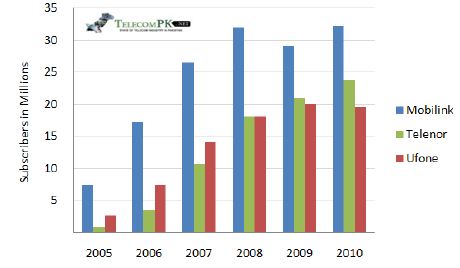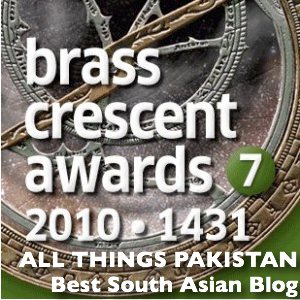Pakistan has now has 100 million mobile phone subscribers.
In a period of a decade Pakistan has gone from a country with minimal telecom infrastructure to a success story when it comes to telecom deregulation, attraction of foreign investment, contribution to economy and growth in subscriber base.
Consumers enjoy far more choices than ever before to select their telecom provider at home, office or for mobile. Prices for domestic and international calls are at their lowest point and broadband Internet cost is approaching the affordable mark. A large number of value added services are available.
Telecom sector has also become one of the major industries in Pakistan, contributing to revenue and leading in foreign investment. Telecom brands have become part of the daily lives of Pakistanis. The sector has been responsible for USF and ICT R&D Fund. Telecom sector has shaped the way corporate social responsibility is perceived in Pakistan. It has also played a vital role when disaster has struck Pakistan.
The sector has been very competitive. The top 3 mobile network operators have 75% of the market: Mobilink, Telenor and Ufone. The chart below gives you a glimpse into the battle for winning over consumers over the last 5 years.
So now that we have reached a major milestone of 100 million subscribers, should we pat our back and go back to business as usual?
Not so fast. I believe that this is just a starting point.
If we want to benefit from this initial growth and make it sustainable then we need to change our approach and step up our efforts to make better use of information and communication technologies. Even though the telecom sector of Pakistan has come a long way, it faces a number of challenges.
- Degradation in quality of network and customer service
- Aggressive price cutting and low ARPUs have made voice and text messaging a commodity
- Saturation of voice and not enough uptake on data services
- Over-emphasis and spending on advertisement
- Rapid shifts in communication modes have impacted our culture in ways which are not always positive
- Imports of phones has caused a strain on foreign reserves
- Digital divide in the country remains an issue
I would argue that the whole sector – private companies, schools and government – has fallen short on supporting research, innovation and creativity which could truly make a difference in the lives of people. In other words, we have reached the first milestone where a significant number of our population can make calls and send text messages. We are missing out on the REAL potential here. And believe me, this is not something that can be easily imported. We need to take this technology and create further value from it.
Engage our youth – the generation which has grown up using mobile phones – and show them productive ways to use communication technologies. My advice would be that The sector should focus on two things: provide economic benefits and to support education for the masses.
When Pakistan reached the 75 million mark in cell phone SIMS back in January 2008, Adil Najam had asked this question, which is still valid :
have we crossed some threshold of excessive cellphone ownership where, despite seemingly low costs, the marginal benefit of ownership no longer exceeds the marginal costs?
My answer is that it depends on what you do with this technology. Playing ring tones is fun but creating best-selling apps or solving problems using your phone is where we want to be. Where we need to be.
Babar Bhatti blogs at Telecom.Net. This post is exclusive to ATP.





















































A country where mobile sims and services getter cheaper day by day and other necessary things are getting expensive.
I also think that these companies are over-rated and they buy off media and even bloggers so that no one is critical of them even when their service is so bad. I used to think Mobilink was bad and moved to Telenor on basis of their ads. They are even worse.
Also, lets not give them more credit than necessary for this whole floods action, it was mostly a gimick. I have friends who work in Telenor who tell me that it was all looked at as a way to get cheap publicity (cheaper than buying ads is how they saw it). So, lets remember these are companies and out to make a buck. Nothing more.
The point Saeed makes is important. It is not just quantity but quality that counts and all the major companies are very bad at that. You realize just how bad after you have looked at networks outside Pakistan. I was recently in Africa and in both Kenya and Tanzania the network was much much better than what Mobilink gives me here.
No matter how many SIMS people have, it is clear that the mobile penetration in Pakistan markets has been tremendous. Although it would be good to estimate how many actual users there might be.
If we average at 3 SIMS per person that will still mean 35,000,000 users. If we average 2 it would mean 50,000,000. Both will be very high numbers still.
The mobile users have increased but as this article points out that has not always been in positive ways. Pakistanis still underutilizes these services and it is not translating into other economic benefits